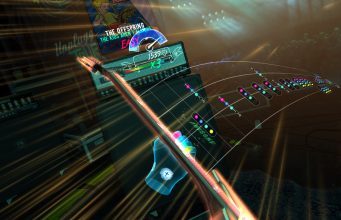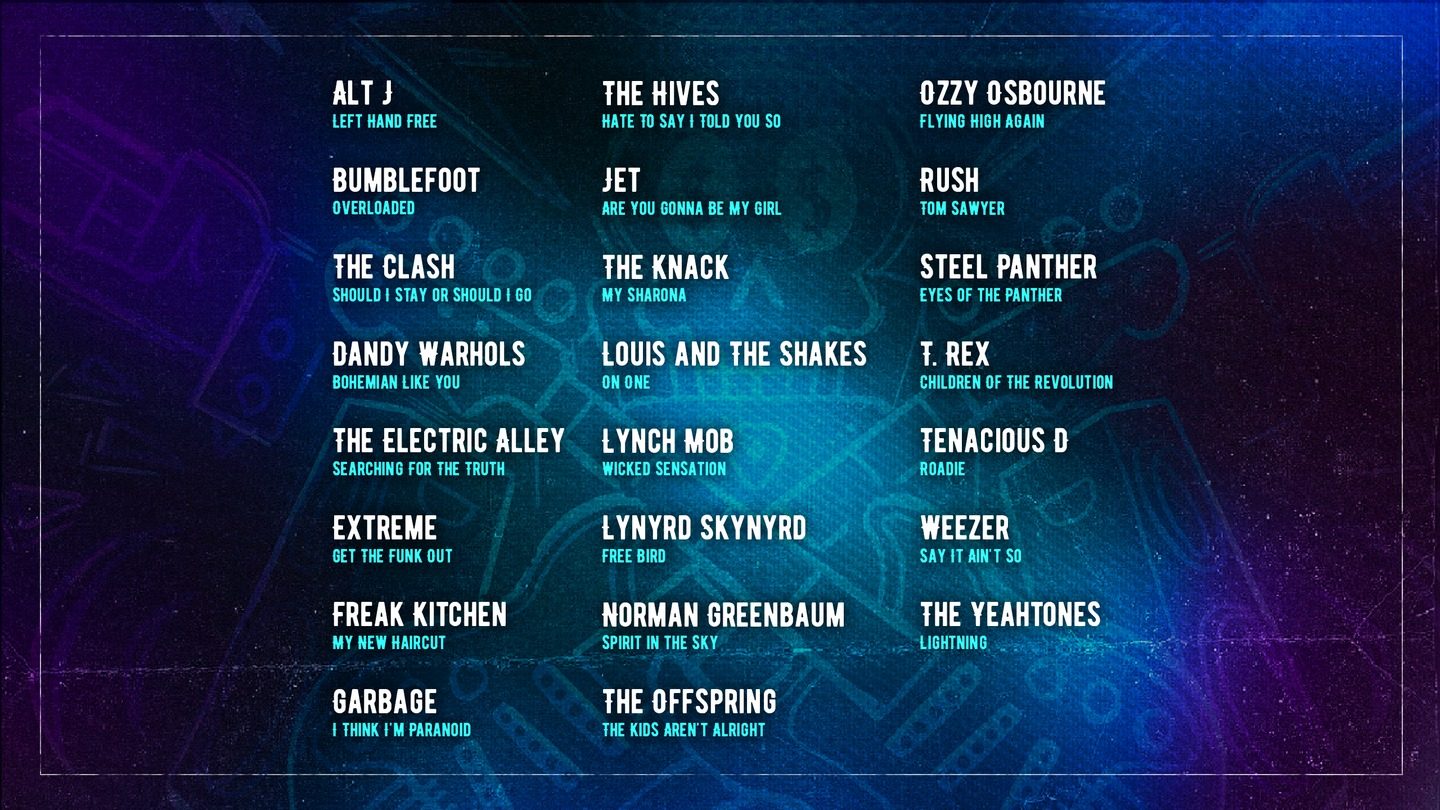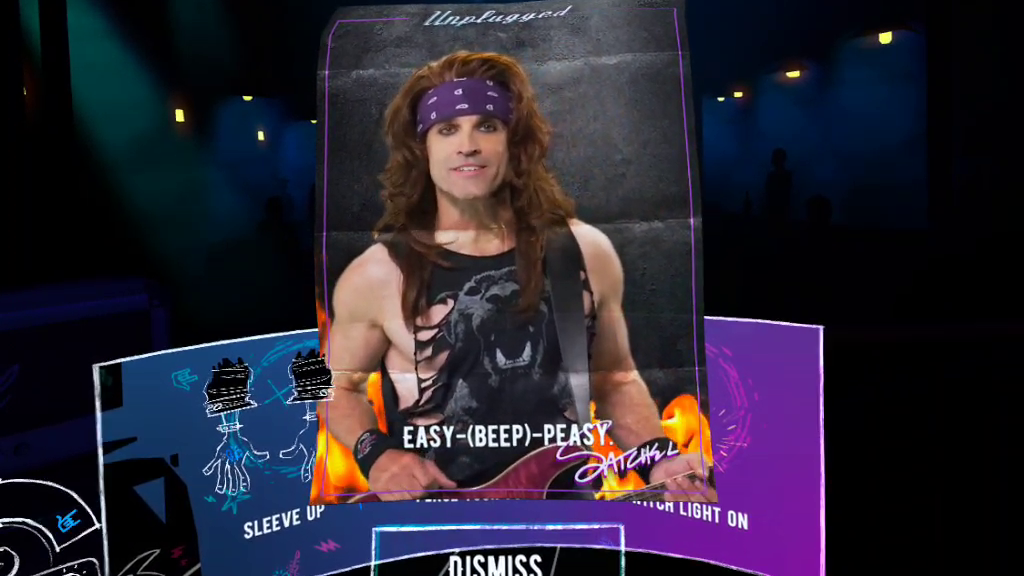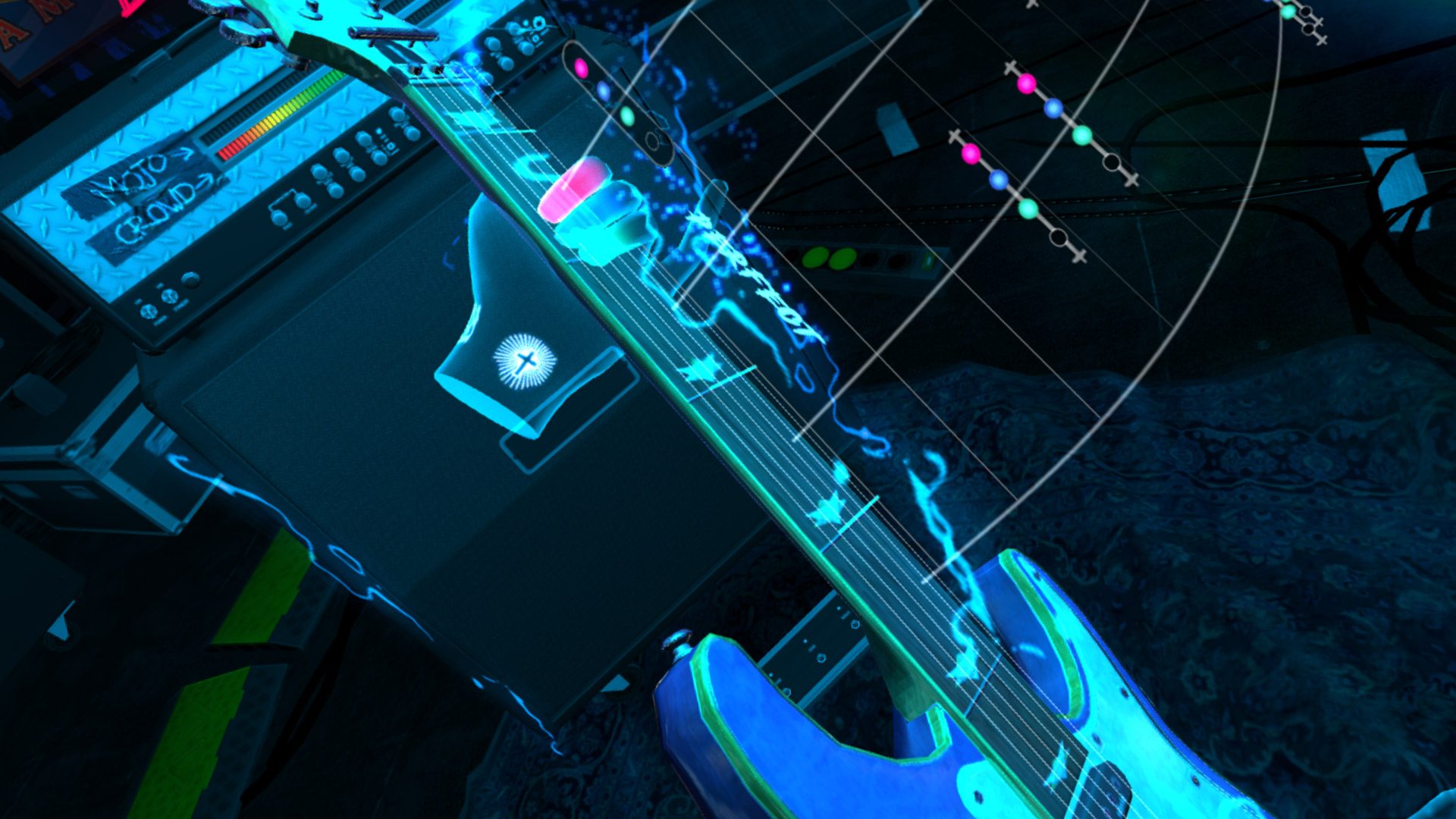
Unplugged is like Guitar Hero, although instead of picking up a dedicated peripheral and jamming away, it relies on Quest’s native hand-tracking to let you shred on an air guitar without controllers. It’s a fun idea that can work really well at moments, however the headset’s optical hand-tracking still isn’t super reliable, which adds a layer of frustration on top of what could truly be a great game.
Unplugged Details:
Available On: Oculus Quest (coming soon to PC VR)
Release Date: October 21st, 2021
Price: $25
Developer: Anotherway
Publisher: Vertigo Games
Reviewed On: Quest 2
Gameplay
Unplugged plops you down, tells you to physically roll up your sleeves, clean the grease from the four camera lenses on your Quest, and start jamming away on an air guitar to an unlockable catalogue spanning 50 years of rock—no dedicated peripherals or Touch controllers required, just hands.
The rhythm game’s launch setlist tosses 23 rock hits your way, and includes an awesome selection of music from bands like The Offspring, Tenacious D, Ozzy Osbourne, Rush, Lynyrd Skynyrd, and more. As a rock fan, I really love the selection here:

Each song is playable in easy, normal and hard difficulty modes, which is determined by the number of different finger positions thrown at you. Each of the game’s five venues contain around five unlockable songs you can play through until you make it to the final gig, an arena packed with an adoring crowd.
Unlike Guitar Hero or Rock Band, which feature dedicated controllers with five buttons placed in specific spots on the guitar’s neck, Unplugged turns the formula on its head by making you perform different fingering positions on a literal air guitar while matching them to four zones on its neck. Like all of those guitar-based rhythm games, you’ll have to strum on the beat to hit each note correctly.
Thankfully you don’t have to constantly stare at the front of the neck itself, as the side also features small indicator lights showing both your current finger position and hand position relative to the four target zones. I’m not entirely sure I’ll ever be able to build the sort of muscle memory that you gain with controller-based rhythm games simply because of how transitory the whole air guitar experience is—and that’s irrespective of Quest’s less than perfect hand-tracking.
And the lack of 100 percent precise hand-tracking is a shame, because everything else about Unplugged is legitimately awesome. The tutorial, which is led by the infectious and suitably glam Steel Panther guitarist ‘Satchel’, teaches you all of the skills you need to get jamming away at your own pace. The music available is all really well known stuff too that is a real joy to jam out to. Ok, I kind of hate Satchel because he’s mean and called me a nerd, but the ’80s douchebag vibe totally fits.

Scoring is pretty typical for rhythm games, and it measures hits in ‘awesome’ and ‘perfect’, with perfect combos netting you more points. It also has what I’d consider a pretty generous buffer before the fail state so I could get through most songs on normal without seeing the dreaded ‘GAME OVER’ screen. One really cool touch: at the end of a particularly good set the audience will toss stuff on stage that you can grab mid-air for extra points.
I still haven’t gotten good enough to do most on hard difficulty though, but that may also come down to hand-tracking throwing me for a loop, which I talk more about below.
Immersion
At first I thought the inherent lack of haptic feedback would stymie the game and make it less fun than a similar controller-based game like Rock Band VR on Rift. Conceptually at least, that’s not true for me. If hand-tracking were more solid I would put it nearly equal to a controller-based rhythm game in the amount of fun and skill you can build. Simply put: when it works, Unplugged is awesome.
And although haptics would undeniably help the game, Unplugged does a good job filling in the gaps with its array of expressive visuals. The game’s beat map follows the neck of your guitar, which means you’ll always have the neck front and center, making it easy to not only tell what finger position you need and where it has to go. Strumming on the other hand (no pun intended) is a binary action that has to be done with a enough force to register.

But even in optimal lighting conditions with a high contrast background, you’re bound to see some jitter and experience some latency too when it comes to hand and individual finger position, which can be super annoying to deal with when you’re trying to build the physical skillset required to hit notes just right.
It feels a bit like having a button on your controller that works 90 percent of the time. That’s more than enough to get you through the experience, and probably even enjoy it, but not enough to inspire confidence in your actions. Here I go through finger counting on both hands just to show how off Quest can be at times. Notice how it hangs on three.
Here’s a few tips to get best case scenario hand-tracking input—if you don’t mind babying Unplugged into having a good time, that is. You have to be very deliberate in your finger positions to make sure they not only register correctly, but also register in enough time for whatever latency there is to resolve itself before you strum to the beat. Definitely take the time to setup your environment so you have a high contrast background and adequate lighting, and you’ll be able to hit that 90ish percent accuracy you’ll need to play and have fun.
Granted, a PC VR version is coming at some point this year, although it will only support controllers with full-fingered tracking like Valve Index. I would much rather play it that way than dealing with the jumpy inaccuracies of Quest’s hand tracking.
Comfort
There’s no artificial locomotion at all, so it can be a really comfortable experience provided you aren’t prone to neck strain.
At first I played Unplugged sort of curled up to get a good view of the guitar’s neck, sort of like a weak impression of Kurt Cobain at MTV Unplugged in New York, circa 1993. You should resist the urge to look down a bunch though and instead position the air guitar more upright so you don’t need to crane your neck so much. Neck muscles aren’t made to deal with off-center weight for long periods of time, so just make sure not to push yourself.
‘Unplugged’ Comfort Settings – October 21st, 2021 |
|
Turning |
|
| Artificial turning |  |
| Smooth-turn |  |
| Adjustable speed | n/a |
| Snap-turn |  |
| Adjustable increments | n/a |
Movement |
|
| Artificial movement |  |
| Smooth-move |  |
| Adjustable speed | n/a |
| Teleport-move |  |
| Blinders |  |
| Adjustable strength | n/a |
| Head-based |  |
| Controller-based |  |
| Swappable movement hand |  |
Posture |
|
| Standing mode |  |
| Seated mode |  |
| Artificial crouch | n/a |
| Real crouch | n/a |
Accessibility |
|
| Subtitles |  |
| Languages | English |
| Alternate audio |  |
| Languages | n/a |
| Adjustable difficulty |  |
| Two hands required |  |
| Real crouch required |  |
| Hearing required |  |
| Adjustable player height | n/a |
The post ‘Unplugged’ Review – Rock Star Ambitions Stifled by Quest’s Hand-tracking appeared first on Road to VR.
from Road to VR https://ift.tt/3jrgwbR
via IFTTT
No comments:
Post a Comment